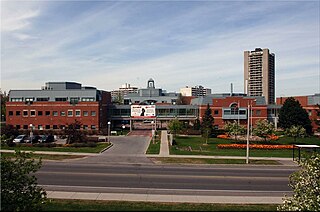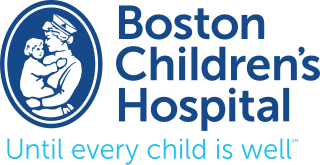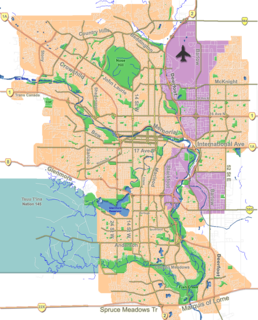It has been requested that the title of this article be changed to The Hospital for Sick Children, Toronto . Please see the relevant discussion. The page should not be moved unless the discussion is closed; summarizing the consensus achieved in support of the move. |
This article includes a list of references, but its sources remain unclear because it has insufficient inline citations .(October 2010) (Learn how and when to remove this template message) |
| The Hospital for Sick Children | |
|---|---|
 | |
 The Hospital for Sick Children from University Avenue | |
| Geography | |
| Location | 555 University Avenue Toronto, Ontario, Canada M5G 1X8 |
| Coordinates | 43°39′26″N79°23′19″W / 43.6571°N 79.3885°W Coordinates: 43°39′26″N79°23′19″W / 43.6571°N 79.3885°W |
| Organisation | |
| Care system | Medicare |
| Funding | Public hospital |
| Hospital type | Specialist |
| Affiliated university | University of Toronto Faculty of Medicine |
| Services | |
| Emergency department | Pediatric Level 1 Trauma Centre (Tertiary) |
| Beds | 453 |
| Speciality | Children's Hospital |
| Helipad | TC LID: CNW8 |
| History | |
| Founded | 1875 |
| Links | |
| Website | www |
The Hospital for Sick Children, corporately branded as SickKids, is a major pediatric teaching hospital located on University Avenue in Toronto, Ontario, Canada. It is affiliated with the Faculty of Medicine of the University of Toronto.
A teaching hospital or university hospital is a hospital or medical center that provides medical education and training to future and current health professionals and that is involved in medical research. Teaching hospitals are often affiliated with medical schools and work closely with medical students throughout their period of matriculation, and especially during their clerkship (internship) years. In most cases, teaching hospitals also offer Graduate Medical Education (GME)/ physician residency programs, where medical school graduates train under a supervising (attending) physician to assist with the coordination of care.

University Avenue is a major north–south road in Downtown Toronto, Ontario, Canada. Beginning at Front Street West in the south, the thoroughfare heads north to end at College Street just south of Queen's Park. At its north end, the Ontario Legislative Building serves as a prominent terminating vista. Many of Toronto's most important institutions are located along the eight-lane wide street such as Osgoode Hall and other legal institutions, the Four Seasons Centre, major hospitals conducting research and teaching, and landmark office buildings for the commercial sector, notably major financial and insurance industry firms. The portion of University Avenue between Queen Street West and College Street is laid out as a boulevard, with several memorials, statues, gardens, and fountains concentrated in a landscaped median dividing the opposite directions of travel, giving it a ceremonial character.

Toronto is the provincial capital of Ontario and the most populous city in Canada, with a population of 2,731,571 in 2016. Current to 2016, the Toronto census metropolitan area (CMA), of which the majority is within the Greater Toronto Area (GTA), held a population of 5,928,040, making it Canada's most populous CMA. The city is the anchor of the Golden Horseshoe, an urban agglomeration of 9,245,438 people surrounding the western end of Lake Ontario. Toronto is an international centre of business, finance, arts, and culture, and is recognized as one of the most multicultural and cosmopolitan cities in the world.
Contents
The hospital's Peter Gilgan Centre for Research and Learning is believed to be the largest pediatric research tower in the world at 69677.28 square metres. [1] Founded in 1875, the hospital was inspired by the example of Great Ormond Street Hospital in London.[ citation needed ]

Great Ormond Street Hospital is a children's hospital located in the Bloomsbury area of the London Borough of Camden, and a part of Great Ormond Street Hospital for Children NHS Foundation Trust.

London is the capital of and largest city in England and the United Kingdom, with the largest municipal population in the European Union. Standing on the River Thames in the south-east of England, at the head of its 50-mile (80 km) estuary leading to the North Sea, London has been a major settlement for two millennia. Londinium was founded by the Romans. The City of London, London's ancient core − an area of just 1.12 square miles (2.9 km2) and colloquially known as the Square Mile − retains boundaries that follow closely its medieval limits. The City of Westminster is also an Inner London borough holding city status. Greater London is governed by the Mayor of London and the London Assembly.
The hospital is located in the Discovery District of Downtown Toronto on University Avenue, adjacent to the Toronto General Hospital and across from Mount Sinai Hospital and the Princess Margaret Cancer Centre—collectively forming a complex known as Hospital Row, each connected by underground tunnels and bridges. The hospital is known for its advertisement campaigns and the largest amounts of donations received for any Canadian hospital.[ citation needed ]

The Discovery District is one of the commercial districts in Downtown Toronto, Ontario, Canada. It has a high concentration of hospitals and research institutions, particularly those related to biotechnology. The district is roughly bounded by Bloor Street on the north, Bay Street on the east, Dundas Street on the south, and Spadina Avenue on the west.

Downtown Toronto is the main central business district of Toronto, Ontario, Canada. Located entirely within the district of Old Toronto, it is approximately 17 square kilometers in area, bounded by Bloor Street to the north, Lake Ontario to the south, the Don Valley to the east, and Bathurst Street to the west. It is also the location of the City of Toronto government and the Government of Ontario.

The Toronto General Hospital (TGH) is a major teaching hospital in Toronto, Ontario, Canada and the flagship campus of University Health Network (UHN). It is located in the Discovery District of Downtown Toronto along a portion of University Avenue known as "Hospital Row"; it is directly north of The Hospital for Sick Children, across Gerrard Street West, and east of Princess Margaret Cancer Centre and Mount Sinai Hospital. The hospital serves as a teaching hospital for the University of Toronto Faculty of Medicine. In 2019, Newsweek ranked TGH as seventh among the top-ten best hospitals in the world. In 2017, the hospital was ranked 1st for research in Canada by Research Infosource.




















